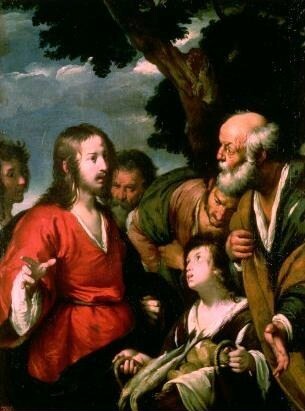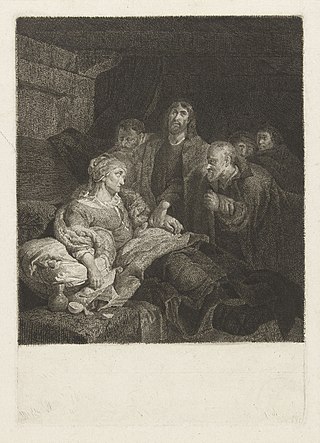
The miracles of Jesus are miraculous deeds attributed to Jesus in Christian and Islamic texts. The majority are faith healings, exorcisms, resurrections, and control over nature.

Matthew 4:24 is the twenty-fourth verse of the fourth chapter of the Gospel of Matthew in the New Testament. This verse is part of a brief summary of and introduction to Jesus' ministry in Galilee, which will be recounted in the next several chapters. This verse relates Jesus' fame "throughout all Syria" and summarizes his work of healing.

Mark 4 is the fourth chapter of the Gospel of Mark in the New Testament of the Christian Bible. It tells the parable of the Sower, with its explanation, and the parable of the Mustard Seed. Both of these parables are paralleled in Matthew and Luke, but this chapter also has a parable unique to Mark, the Seed Growing Secretly. The chapter ends with Jesus calming the storm.

Mark 5 is the fifth chapter of the Gospel of Mark in the New Testament of the Christian Bible. Taken with the calming of the sea in Mark 4:35–41, there are "four striking works [which] follow each other without a break": an exorcism, a healing, and the raising of Jairus' daughter.

Mark 6 is the sixth chapter of the Gospel of Mark in the New Testament of the Christian Bible. In this chapter, Jesus goes to Nazareth and experiences rejection by his own family. He then sends his Apostles in pairs to various cities in the region, where they might also face rejection. Finally, Jesus goes back to the Sea of Galilee and performs some of his most famous miracles, including the feeding of the 5000 and walking on water. This chapter also gives an account of the murder of John the Baptist.

In Christianity, feeding the multitude comprises two separate miracles of Jesus, reported in the Gospels, in which Jesus used modest resources to feed thousands of followers who had gathered to see him heal the sick.

Matthew 9 is the ninth chapter of the Gospel of Matthew in the New Testament. It continues the narrative about Jesus' ministry in Galilee as he ministers to the public, working miracles, and going through all the cities and towns of the area, preaching the gospel, and healing every disease. This chapter opens with Jesus back in "his own town", i.e. Capernaum. This chapter reflects "the crucial role of faith" in relation to healing.

Matthew 14 is the fourteenth chapter in the Gospel of Matthew in the New Testament section of the Christian Bible. It continues the narrative about Jesus' ministry in Galilee and recounts the circumstances leading to the death of John the Baptist.

Luke 5 is the fifth chapter of the Gospel of Luke in the New Testament of the Christian Bible, traditionally attributed to Luke the Evangelist, a companion of Paul the Apostle on his missionary journeys. The chapter relates the recruitment of Jesus' first disciples and continues to describe Jesus' teaching and healing ministry. Early criticism from the Jewish religious authorities is encountered as the chapter progresses.

Luke 8 is the eighth chapter of the Gospel of Luke in the New Testament of the Christian Bible. The book containing this chapter is anonymous but early Christian tradition uniformly affirmed that Luke the Evangelist, a companion of Paul the Apostle on his missionary journeys, composed both this Gospel and the Acts of the Apostles. This chapter mentions the women who supported Jesus and records some of the great miracles he performed, as well as several parables told by him.

Luke 9 is the ninth chapter of the Gospel of Luke in the New Testament of the Christian Bible. It records the sending of the twelve disciples, several great miracles performed by Jesus, the story of his transfiguration, Peter's confession and the final departure from Galilee towards Jerusalem. Scottish minister William Robertson Nicoll describes this chapter as unfolding "sundry particulars which together form the closing scenes of the Galilean ministry". The book containing this chapter is anonymous, but early Christian tradition uniformly affirmed that Luke the Evangelist composed this Gospel as well as the Acts of the Apostles.
Matthew 9:20 is a verse in the ninth chapter of the Gospel of Matthew in the New Testament.

Matthew 8:14 is the fourteenth verse of the eighth chapter of the Gospel of Matthew in the New Testament. This verse and the following verse constitute a "simple short story" in which Jesus heals Peter's mother-in-law.

Matthew 15:1 is a verse in the fifteenth chapter of the Gospel of Matthew in the New Testament.

Each of the three Synoptic Gospels tells of Jesus healing the blind near Jericho, as he passed through that town, shortly before his passion.
Christianity and fringed garments refers to the mention of fringed garments in Christian sources, and to the Christian appropriation of Jewish rituals, tzitzit and tallit.

The raising of Jairus' daughter is a reported miracle of Jesus that occurs in the synoptic Gospels, where it is interwoven with the account of the healing of a bleeding woman. The narratives can be found in Mark 5:21–43, Matthew 9:18–26 and Luke 8:40–56.

The healing of the mother of Peter's wife is one of the miracles of Jesus in the Gospels, reported in Matthew 8:14–15, Mark 1:29–31, and Luke 4:38–39.

Jesus healing the bleeding woman is one of the miracles of Jesus recorded in the synoptic gospels.

The synoptic gospels portray Jesus exorcising at sunset just after he had healed the mother of Peter's wife, in Matthew 8:16–17, Mark 1:32–34 and Luke 4:40–41.


















